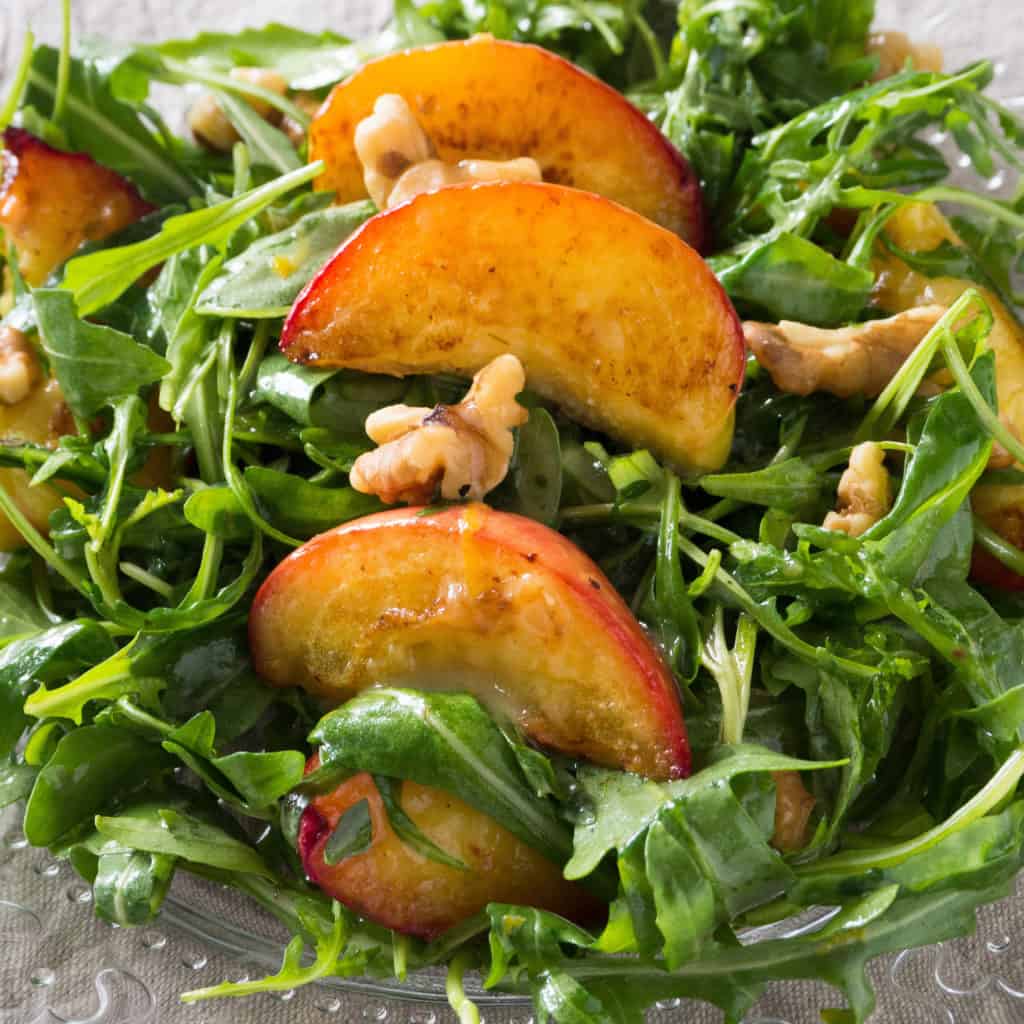
Grilled Nectarine Salad with Rocket and Walnuts is a joy to look at and eat. The seasonal, grilled, nectarines should be just soft enough to yield to a fork and sweet and delicious with the vinaigrette dressing. The rocket and walnuts add a savoury, mustardy, edge to the sweetness of the nectarines. Eaten at dusk with a cook drink after a hard day at work – this is summer on a plate.
Super easy to make, Grilled Nectarine Salad with Rocket and Walnuts is ready in less than 20 minutes.
Find the full Grilled Nectarine Salad with Rocket and Walnuts recipe here.
Grilled Nectarine Salad with Rocket and Walnuts is perfect for lunch, light dinner or as a starter for a special meal. Serve with Beetroot and Millet Mega-Salad. Also great served with Carrot and Lemon Soup for a hearty summer lunch or wonderful as a starter to a main meal such as Ratatouille.
You can use a griddle pan (or barbeque) to grill the nectarines and leave classic grill lines. But if you don’t have either of these to hand you can use a normal frying pan.
It is important to use ripe (but not too soft) nectarines in this dish. Too hard and the grilling will not bring out the best in the nectarines, too soft and the nectarines will fall apart.
Preparation
Difficulty easy
Preparation time 20 minutes
Cooking time 0 minutes
Find the full Grilled Nectarine Salad with Rocket and Walnuts recipe here.
Allergens
Grilled Nectarine Salad with Rocket and Walnuts is gluten-free and vegan as well as…
Celery free
Coconut free
Garlic free
Lupin free
Mustard free*
Nightshade free
Onion free
Peanut free
Sesame free
Soya free
Tree nut free*
*To make Grilled Nectarine Salad with Rocket and Walnuts tree-nut free leave out the walnuts and use rapeseed oil in the vinaigrette.
*To make Grilled Nectarine Salad with Rocket and Walnuts mustard free dress the salad with oil and vinegar.
About
Nectarines are essentially a ‘fuzzless’ peach.
A genetic variant of common peaches (prunus persica), the nectarine (prunus persica var. nucipersica) was probably domesticated in China more than 4000 years ago. Nectarine and peach trees are virtually indistinguishable from each other. The expression of a recessive allele is thought to be responsible for the smooth skin of nectarine fruits, which lack the fuzzy trichomes (plant hairs) characteristic of peach fruits. The stones and kernels of the two fruits are alike in appearance and may be freestone types (which have ripe flesh that separates easily from the stone) or clingstones (which have flesh that adheres firmly to the stone). Nectarines have red, yellow, or white flesh and are a source of vitamins A and C.
When peaches are crossed or self-pollinated, resulting seeds that carry the recessive allele for smooth skin will give rise to nectarines, while those that carry the dominant allele will be peaches. Nectarines may sometimes appear on peach trees as a result of the bud variation process, or bud sporting, a vegetative deviation from the normal.
Alexander the Great introduced the peaches and nectarines into Europe. Peaches were well known to the Romans in first century AD and were cultivated widely in Emilia-Romagna. Peach trees are portrayed in the wall paintings of the towns destroyed by the Vesuvius eruption of 79 AD. The oldest known artistic representations of the fruit are in the two fragments of wall paintings, dated back to the first century AD, in Herculaneum, now preserved in the National Archaeological Museum in Naples.
The peach was brought to the Americas by Spanish explorers in the 16th century and made it to England and France in the 17th century, where it was a prized and expensive treat.
A medium peach, weighing 100 grams, contains small amounts of essential nutrients, but none is a significant proportion of the RDA. Nectarines have similar low content of nutrients. The glycemic load of an average peach (120 grams) is 5, similar to other low-sugar fruits. Peaches and nectarines are of limited nutritional value containing only 8 % of the RDA of vitamin C per 100 grams. Not great but ripe, seasonal peaches and nectarines do taste good!
The peach belongs to the genus prunus which includes the cherry, apricot, almond and plum, in the rose family. The peach is classified with the almond in the subgenus amygdalus, distinguished from the other subgenera by the corrugated seed shell. The peach is a common allergen and is often linked to an allergy to almonds.